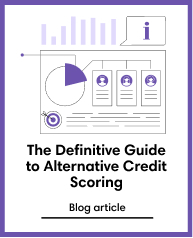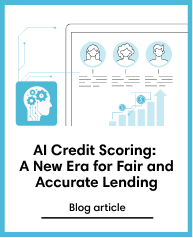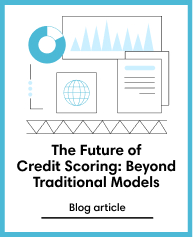Credit Scoring
Dec 31, 2021
3 key steps for any credit analysis
Subscribe to our newsletter
A credit study is the first step for any person or company seeking a loan. It carefully gauges an applicant’s overall solvency, repayment capacity, income stability, and the broader magnitude of potential credit risk.
Traditional credit analysis generally follows three structured steps: thorough information gathering, comprehensive financial analysis, and careful decision-making to determine creditworthiness.
Modern approaches add alternative data and machine learning (ML) to boost predictive power and speed. This credit analysis process creates consistent, auditable outcomes across portfolios.
What Is Credit Analysis?
Credit analysis is the systematic process of evaluating a borrower’s financial and behavioural profile to determine their creditworthiness—that is, their ability and willingness to repay borrowed funds.
Fundamentally, it involves analysing quantitative data such as financial statements, income, debt levels, and credit history, alongside qualitative factors like payment behaviour and external economic conditions.
The objective is to estimate the risk of default by assessing both the borrower’s financial capacity and their behavioural reliability, enabling lenders to make informed, risk-adjusted lending decisions.
This evaluation is grounded in financial theory and risk management frameworks that balance expected returns against potential credit losses.
Why Credit Analysis Matters in Lending Decisions
Credit analysis guides approvals, pricing, and limits, improving portfolio outcomes and compliance. It also reduces default risk by ensuring lending decisions are based on structured, data-driven evaluations.
Who Performs Credit Analysis? (Banks, fintechs, lenders)
Banks, fintechs, and lenders apply it across retail, small-business, and corporate lending, including mortgages and leasing. Regulators and investors also rely on its insights to assess institutional risk exposure and financial stability.
Information gathering
At this initial stage, banking information such as credit extensions, payment history and sources of recovery is required. For example, in the case of a company requesting a loan, credit analysis would look into future investments and how the loaned funds will be used up.
The lenders will then carefully investigate whether the person, whether physical or legal, possesses any guarantee or collateral that can assure the full recovery of the debt in case of default.
Information analysis
In traditional credit scoring, this stage begins with the verification of documents such as identity (ID), passport, and business licenses, among others. It continues with the study of past financial information such as balance sheets, financial statements, cash flow, etc.
In a company, the scope of the project is also studied to assess the project’s scalability, its business performance, competition levels and company growth.
Analysts use this data to understand potential risks and whether the person or institution will have sufficient liquidity to pay the loan. This whole process can take a long time since it is done manually.
For practitioners asking how to do credit analysis of a company, these structured steps clearly illustrate the core review areas, including financial health, risk exposure, and repayment capacity.
Unlike traditional credit studies, new alternative credit analysis uses ML algorithms, which accelerate processes, allowing credit scores to be obtained automatically. This means better customer service and the ability to respond to multiple requests.
Decision making
In a traditional credit analysis model, once the analyst has collected and verified the information, they identify the risk and send their recommendation, be it positive or negative, to a credit committee that will make the final decision. This results in more time delays.
Alternative credit analysis is superior in this last step as well, since systematisation avoids human errors and facilitates new types of data processing that obtain accurate credit profiles.
However,with the use of ML intelligence, the ability to learn continuously is amplified. This allows models to improve and to obtain more accurate behaviour patterns over time, enabling lenders to make informed decisions.
Credit Analysis vs Credit Assessment: What’s the Difference?
Credit analysis is the focused evaluation of a borrower’s likelihood to repay a loan. It involves gathering and validating financial and behavioural data to estimate credit risk. This stage centres purely on assessing the borrower’s repayment capacity and willingness.
Credit assessment, on the other hand, refers to the entire end-to-end workflow that leverages the insights from credit analysis and integrates them with additional components such as credit scoring models, fraud detection, policy rules, and compliance checks.
This broader process operationalises credit decisions at scale, often using machine learning to combine traditional bureau data with behavioural and device metadata. This integration enhances predictive accuracy and risk differentiation while maintaining fairness and regulatory standards.
How to Perform a Credit Analysis
If you are wondering how to perform credit analysis, follow these steps as a practical checklist.
- Define objective and policy scope.
- Clarify product, limits, collateral, and risk appetite.
- Collect multi-source data.
- Blend financials with alternative data such as telco, utility, and behavioural/device metadata to achieve a 100% hit rate at the application.
- Validate identity and integrity.
- Run device integrity, emulator, and proxy checks to stop synthetic identities early.
- Engineer features and train ML models on outcome data.
- Tailor scorecards per segment and measure Gini/KS by region and use case.
- Stress-test and calibrate.
- Back-test across cohorts; ensure low correlation with bureau data for additive lift (orthogonality).
- Decide and explain.
- Combine scores with policies and reason codes to approve, refer, or decline consistently.
- Monitor, retrain, and govern.
- Ensure privacy-consented, anonymised, non-PII metadata; comply with the General Data Protection Regulation (GDPR) and Consumer Credit Protection Act (CCPA), among others.
Credit Analysis: Use Cases
Credit analysis involves a comprehensive evaluation of a borrower’s financial health and behaviour to determine their creditworthiness. The following sections outline key steps and data sources that enable lenders to make informed, timely, and accurate lending decisions.
Balance Sheet Evaluation
Analysts begin by reviewing liquidity indicators such as cash reserves, receivables ageing, and inventory turnover. They assess leverage through debt-to-equity ratios and monitor working capital changes to set prudent credit limits. Cash flow from operations is measured against interest payments and short-term debt amortisations using coverage ratios to gauge repayment capacity.
Assessing Market Position
Understanding a borrower’s market position involves analysing customer and supplier concentration, pricing power, and competitive intensity. Exposure to seasonality and potential logistics disruptions is also examined to shape covenant structures and stress test scenarios.
Enhancing with Behavioural Data
Traditional bureau and bank data are enriched with privacy-consented device and behavioural metadata collected during SME digital applications. These smartphone and web interaction signals, analysed via machine learning, provide an independent and complementary view of the borrower’s willingness and ability to repay.
Real-Time Fraud Detection
Simultaneous fraud screening identifies suspicious patterns, including device farms, rapid application submissions, and automation signals, which are often associated with synthetic identities. This helps ensure that only legitimate applications move forward in the process.
Outcome and Benefits
Approvals come with enhanced early-warning triggers and post-disbursement monitoring tailored to cash flow variability. By combining classic financial analysis with behavioural insights, lenders make faster, more consistent decisions with improved risk separation.
Why This Approach Works
Alternative data increases predictive accuracy and extends lending access to thin-file and newer borrowers. This supports faster, fairer lending decisions, especially for SMEs leveraging digital channels.
The Credit Assessment Process: Traditional vs. Alternative
The credit assessment process is the operational workflow that transforms credit analysis into policy-backed lending decisions, spanning three core stages: application, evaluation, and decision.
Traditional and alternative methods differ significantly in their data sources, techniques, and speed, especially with the rise of behavioural signals and machine learning (ML).
Application Stage:
In traditional methods, borrowers fill out forms, provide Know Your Customer (KYC) documents, and allow lenders to check their credit history through credit bureaus. This can take a lot of time and involve lots of paperwork.
Alternative methods add more information by using device and behavior data that borrowers agree to share. This includes how they interact with their device, the environment they are in, and how they use apps or websites—all collected instantly.
This helps lenders quickly check the borrower’s intention, confirm their identity, and ensure the application is complete right from the start.
Evaluation Stage:
Usually, lenders look at fixed financial documents and credit bureau reports. These may not always have enough or up-to-date information, especially for new borrowers or those with little credit history.
Using machine learning, behavioral and device data give a fresh, different view from traditional data. These models create risk scores, spot possible fraud, and explain their findings in real time. This helps lenders find risks more accurately and faster than manual checks or old data.
Decision Stage:
In older systems, credit decisions rely on fixed rules and review committees. This takes longer, can lead to inconsistent outcomes, and is hard to scale for many applications.
Newer methods use machine learning risk scores alongside policy rules to automatically approve clear cases. Difficult or unclear cases are checked by humans.
This mix speeds up approvals, makes decisions more consistent, and keeps fairness, transparency, and compliance with regulations.
Synergistic Benefits:
Bringing together traditional credit data and behavioral data improves prediction accuracy and lowers risk costs. It also allows more people, especially those with limited credit history, to access credit.
This approach combines trusted credit information with real-time behavioral insights powered by machine learning. It builds a credit assessment system that is strong, flexible, and scalable.
In summary, traditional credit assessment depends on static financial information and manual steps. Alternative, data-driven methods add real-time behavioral insights using machine learning, making credit decisions faster, fairer, and more inclusive.
Conclusion
Credit analysis is evolving from paper-heavy checks to ML-powered, behavioural-aware decisioning. By uniting traditional data with alternative metadata, lenders achieve faster, fairer, and more predictive outcomes.
Credolab’s privacy-by-design approach turns device and behavioural metadata into real-time scores and insights via one unified Application Programming Interface (API). That strengthens risk assessment, cuts fraud, and improves marketing effectiveness.
FAQs About Credit Analysis
How is behavioural data used in modern credit scoring?
Behavioural biometric metadata and device fingerprint metadata, like typing cadence, field edits, app usage patterns, and device integrity, create a live picture of intent and consistency at onboarding. Used with bureau data, it improves predictive power and inclusivity.
What’s the role of machine learning in credit analysis?
ML automates feature discovery and score generation from large, diverse datasets, enabling outcome-based scorecards tailored by product and region. It delivers real-time, explainable risk signals into decisioning flows.
Can people with no credit history still be analysed?
Yes. Alternative data, such as telco, utility, e-commerce, and privacy-consented device and behavioural metadata, supports 100% coverage at the application and robust risk separation for thin-file or new-to-credit users. This expands access without compromising prudence.





